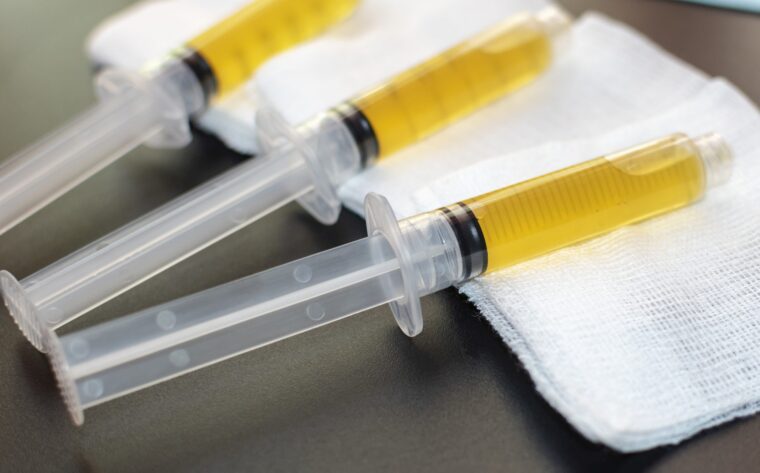Platelet Rich Plasma injections offer treatment that has shown positive results for patients suffering with joint pain, an array of sports related injuries and even hair loss. Though there are different stem cell sources, stem cells used in this treatment come from the patient’s own blood.
Understanding stem cells and stem cells research is important. The progression of this particular area of study in medical science has an extensive history that reaches much further back in time than most people are aware.
To begin with, it’s important to understand that stem cells are the basic building blocks of life and have the potential to differentiate into many different types of cells within the body. Stem cells are actively involved in repairing, regenerating, and rebuilding damaged or absent tissue in the body that has been affected by disease, infection, or injury. To that end, Platelet Rich Plasma injections, particularly in the area of joint pain treatment, is a direct result of stem cell research, research that goes all the way back to the mid-1800’s.
The science of stem cell research may appear to be a very recent area of medical study. But in reality, stem cell research has a history that goes back more than a century, beginning with its earliest discovery in the mid-19th century. Though research techniques were rudimentary by today’s standards, by the turn of the 20th century, medical science had discovered that stem cells could, indeed, generate blood cells.
In the decades that followed, further research resulted in remarkable breakthroughs as one new advancement in the field built upon another. Ultimately this led to all stem cells being classified into three categories, based on the cells’ ability to “differentiate.”

The Totipotent stem cells, found in early embryos, was found to have the capacity to form a complete organism. Pluripotent stem cells were found to exist in the “undifferentiated” inner cell mass of the blastocyst, with the ability to form into any one of the more 200 different cell types that make up the human body. And Multipotent stem cells, which are derived from fetal tissue, adult stem cells and cord blood, which are somewhat more limited than Pluripotent stem cells, have shown promise when used in cell-based therapies.
Perhaps the best known application of stem cell research has been bone marrow transplants. In the early 1900’s, when research was still in its infancy, doctors would orally administer bone marrow to patients suffering with anemia and even leukemia. Initially the therapy was unsuccessful, but results involving experiments on mice with defective marrow found that their conditions could be restored through injections directly into the bloodstream, using marrow taken from other mice.
In France in the 1950’s, researchers discovered that it was possible to transplant bone marrow from one human to another, a procedure known as an allogeneic transplant. But performing such transplants in humans was not attempted on a larger scale until a French medical researcher, Jean Dausset made a crucial discovery about the human immune system in 1958. Dr. Dausset was able to identify proteins found on the surface of most cells in the human body called human leukocyte antigens. The human antigens is what gives the body’s immune system the ability to differentiate what belongs in the body or what cells should be destroyed by naturally occurring antibodies in the body.
Once this was clearly understood, the first bone marrow transplant in humans was performed, involving identical twins. This, researchers felt, would guarantee compatibility between the donor and the recipient. Further study gave researchers the understanding to take the sibling stem cell transplants to the next level. By the 1960’s researchers were performing transplants between siblings who were not identical twins. Then in 1973, physicians performed the very first “unrelated” donor to recipient bone marrow transplant, which was actually a series of seven transplants.

By the 1980’s, Congress had become involved with legislation that provided the groundwork for what, in 1984, became the National Organ Transplant Act. The Organ Transplant Act provided the necessary guidelines needed to evaluate unrelated marrow transplantation and, ultimately, establishing a national donor registry. It was called the National Marrow Donor Program, a non-profit organization that oversaw the administration of the national database.
By the 1990’s, the success rate of the bone marrow transplant program had grown exponentially. Since then, more than 16,000 transplants have provided treatments for immunodeficiencies and leukemia. Today, adult stem cells show great promise in the treatment and repair of organs that have been ravaged by diseases.
This is where platelet rich plasma injections, particularly in the area of joint pain treatment, enter the picture.
Platelet Rich Plasma (PRP) is derived from the peripheral blood of the patient being treated and consists of two elements. The first is the plasma. That is the liquid portion of blood. The second element are the platelets.
Platelets are the blood cells that are key to the entire healing process throughout the body because they contain growth factors. This stimulates the all important tissue regeneration, which is to say, the healing needed in the treated area through cell reproduction. Platelet-rich plasma is plasma that contains a higher platelet count than normal.

Platelet-rich plasma is created when a blood sample from the patient is placed in a centrifuge which rapidly spins the sample in order to concentrate the platelets within the plasma by separating them from other components of the blood. PRP contains a small amount of stem cells and the healing capability is due to the bioactive molecules present in the injection.
Once inside the body, receptors on stem cells allow them to migrate to areas that need healing and affect the regenerating changes needed in that area, potentially becoming new cells in the area and creating new tissue to help improve functionality. They accomplish this by secreting certain chemicals which cause the body’s existing stem cells to initiate tissue regeneration.
Since the stem cells are taken from the patient’s own blood, there are no compatibility issues, and Platelet Rich Plasma injections can be used to treat a myriad of conditions, ranging from sports injuries and joint pain to hair loss.
If you are seeking this type of treatment consult a qualified physician or practice. A good example of a practice that has utilized this treatment successfully is Integrated Orthopedics. Do your research and make informed decisions on your health.
